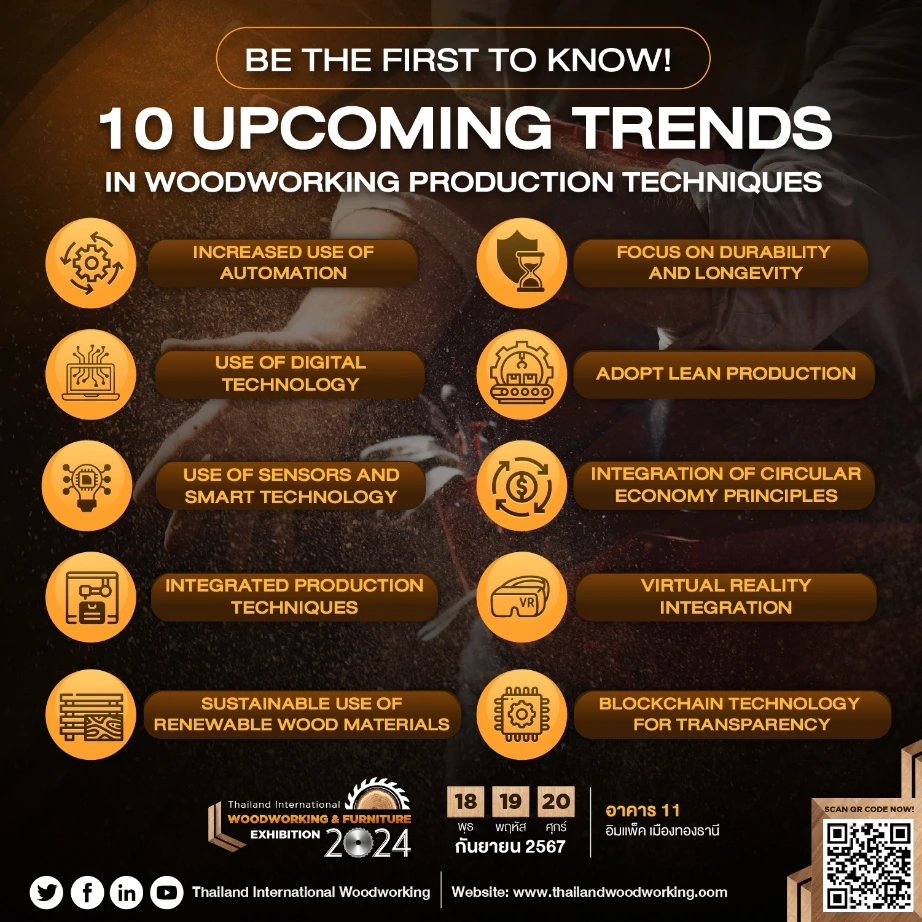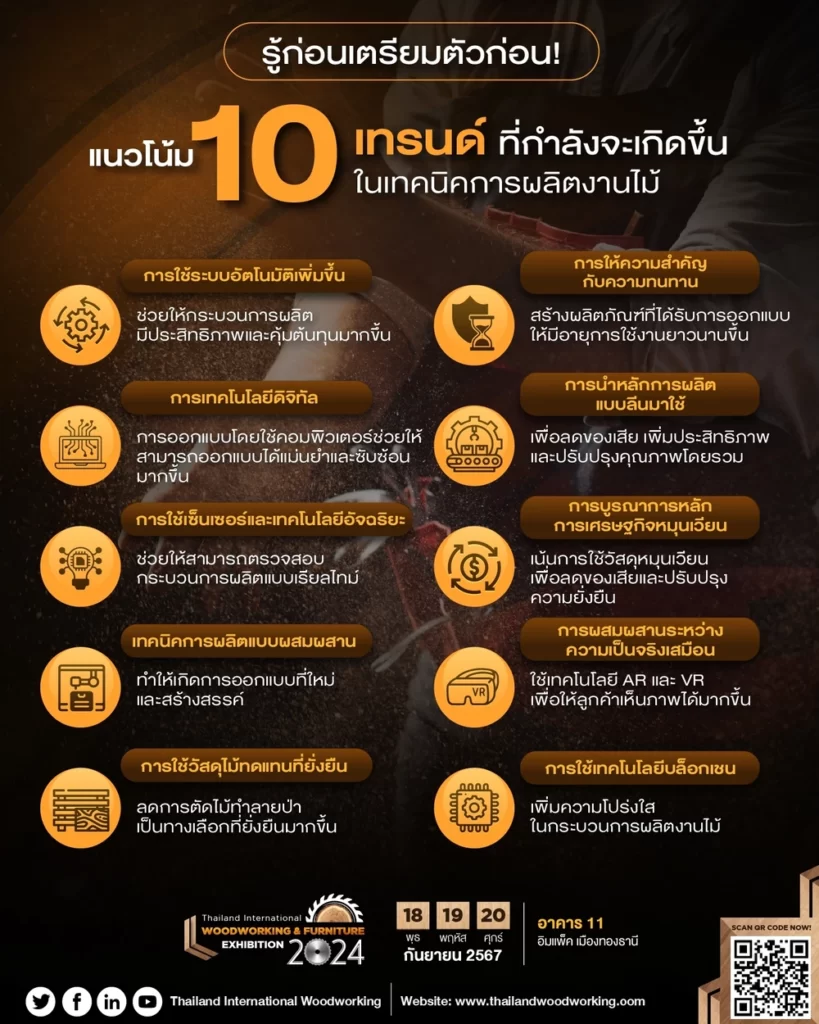Today, Thailand International Woodworking and Furniture 2024 (TIWF 2024) has compiled a list of 10 key trends in woodworking production techniques that will drive the competitiveness of Thailand’s woodworking industry, and set the direction for its future development and growth.
Increased use of Automation: Assisting in the enhancement of the production process to be more efficient and cost-effective.
Digital Technology: 3D-printing and computer-aided design enabling more precise and complex designs.
Use of Sensors and Smart Technology: Allowing simultaneous monitoring and optimization of production processes.
Integrated Production Techniques: Merging of new and traditional woodworking techniques, resulting in unique and innovative designs.
Sustainable use of Renewable Wood Materials: Helping in reducing deforestation, such as the use of bamboo or processed recycled plastic timber, to ensure a more sustainable option.
More focus on Durability and Longevity: Designing wooden products to last longer and to reduce waste impacting the environment.
Adopting Lean Production Principles: Reducing waste, enhancing efficiency, and improving overall quality.
Integration of the Circular Economy Principles: Focusing on the use of recycled materials and a closed-loop production process to minimize waste and promote sustainability.
Virtual Reality Integration: Using of AR and VR technologies to provide visualization to customers and customize wood products in more immersive and interactive ways.
Blockchain Technology for supply chain transparency: Enhancing transparency and traceability in the wood supply chain, ensuring that wood products are ethically and sustainably sourced.
Source: Deskera
แนวโน้ม 10 เทรนด์ ที่กำลังจะเกิดขึ้นในเทคนิคการผลิตงานไม้
วันนี้ TIWF 2024 ได้รวบรวม 10 เทรนด์สำคัญในเทคนิคการผลิตงานไม้ ที่จะช่วยเพิ่มขีดความสามารถในการแข่งขันของอุตสาหกรรมงานไม้ไทย และช่วยกำหนดทิศทางสำหรับการพัฒนาและการเติบโตของอุตสาหกรรมในอนาคต
การใช้ระบบอัตโนมัติเพิ่มขึ้น : ช่วยให้กระบวนการผลิตมีประสิทธิภาพและคุ้มต้นทุนมากขึ้น
การเทคโนโลยีดิจิทัล : การพิมพ์ 3 มิติ และการออกแบบโดยใช้คอมพิวเตอร์ช่วยให้การออกแบบมีความแม่นยำและซับซ้อนมากขึ้น
การใช้เซ็นเซอร์และเทคโนโลยีอัจฉริยะ : ช่วยให้สามารถตรวจสอบกระบวนการผลิตแบบเรียลไทม์และเพิ่มประสิทธิภาพการผลิตได้
เทคนิคการผลิตแบบผสมผสาน : ทำให้เกิดการออกแบบที่เป็นเอกลักษณ์และสร้างสรรค์มากขึ้น
การใช้วัสดุไม้ทดแทนเพิ่มความยั่งยืน : ลดการตัดไม้ทำลายป่า เช่น ใช้ไม้ไผ่หรือไม้แปรรูปพลาสติกรีไซเคิล เพื่อเป็นทางเลือกการผลิต ผลิตภัณฑ์ไม้ที่ยั่งยืนมากขึ้น
การให้ความสำคัญกับความทนทานของผลิตภัณฑ์ : สร้างผลิตภัณฑ์ที่ให้มีอายุการใช้งานยาวนานขึ้น และทนทานต่อการสึกหรอ เพื่อลดขยะ
การนำหลักการผลิตแบบลีนมาใช้ : เพื่อลดของเสีย เพิ่มประสิทธิภาพ และปรับปรุงคุณภาพโดยรวม
การบูรณาการหลักการเศรษฐกิจหมุนเวียน : เน้นการใช้วัสดุหมุนเวียนและกระบวนการผลิตแบบวงปิด เพื่อลดของเสียและปรับปรุงความยั่งยืน
การใช้เทคโนโลยี AR และ VR : เทคโนโลยีนี้ จะถูกนำมาใช้เพื่อให้ผู้บริโภคเห็นภาพผลิตภัณฑ์ได้อย่างชัดเจน และสร้างประสบการณ์ในการเลือกซื้อสินค้ามากขึ้น
การใช้เทคโนโลยีบล็อกเชน : เพื่อเพิ่มความโปร่งใสในกระบวนการผลิตงานไม้ แหล่งที่มาของผลิตภัณฑ์ไม้ต้องตรวจสอบได้
ขอบคุณข้อมูลดี ๆ จาก : Deskera


